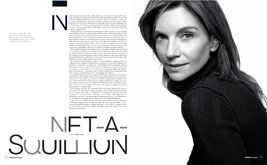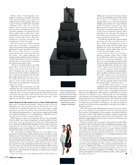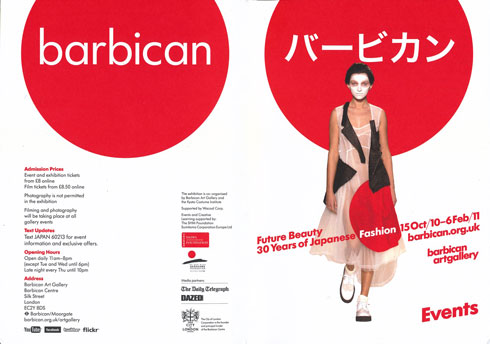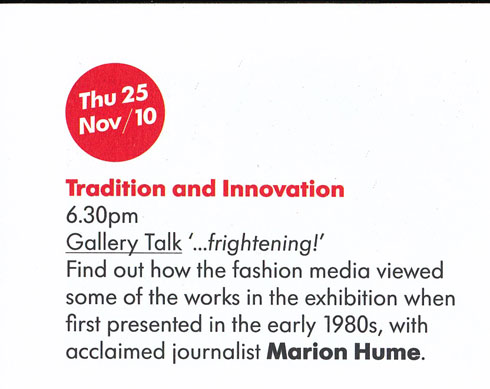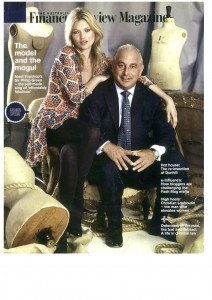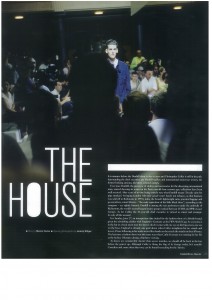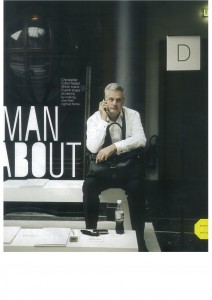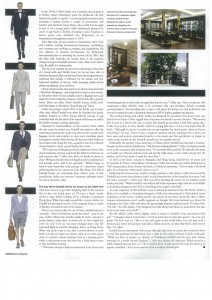NET-A-SQUILLION
Net-a-Porter. Natalie Massenet
The AFR magazine December 2010
by Marion Hume
Ten years into the life of the web’s most successful high- fashion salon, former journalist Natalie Massenet’s Net-a-Porter is fast growing and fabulous
Natalie Massenet makes me feel like an idiot. Not because this woman who changed the way we shop isn’t charming. And heavens, she’s chic in her teeny white shirt layered over a long T-shirt and leather leggings, rolled up today because cropped is so this season. No, the reason is because she was so right and I was so wrong. You want some numbers on that? How about 3 million unique users, 171 countries, 1,000 employees, annual sales topping more than £300 million and – here’s the zinger – the company was acquired by Richemont, the world’s second-largest luxury group, in a deal valuing Net-a-Porter at £350 million. And it was me who thought, “I hope she doesn’t give up the day job.”
Massenet used to be a fashion editor. One morning more than a decade ago we were standing in the aisle after a Paris show and she told me about her notion to sell designer fashion over the internet, which sounded nuts because, of course, women always want to handle and try on the clothes first, don’t they? But what makes my own lack of vision considerably easier to bear is that, back then, Massenet was only looking for my interest, not my investment. Imagine how idiotic those who passed on that opportunity felt in April when the Richemont deal went through. As to those who did see the light, some were to be found packing boxes the day after multiples of millions hit their bank accounts. It was a Saturday, but staffers showed up anyway to prepare for moving offices. Massenet, who pocketed £50 million, was busy vacuuming.
But it should be remembered that in the run-up to Net-a-Porter’s launch in 2000, the appeal of a vast selection of skilfully curated designer pieces, available for purchase 24/7, and arriving at your door tied with a bow, did not seem the no-brainer it does today. The internet’s promise of low operating costs and high profits seemed so tricky to translate to fashion back then. When Massenet launched with an £850,000 war chest raised from friends and private investors, better funded start-ups were crashing and burning around her.
She succeeded because she understood that it was about indulgence and that geek side was nothing more than a sideshow. Although she is recognised as one of the world’s leading internet entrepreneurs, her big idea was a simple wish – that the things she loved in magazines could pop off the page and into her wardrobe. The beauty is that Massenet has always insisted hers is a service business, a fashion business, hence, from day one, packages done up like a special gift are part of the transaction. (Customers are able to request a discreet brown paper bag instead, where verbiage on the inside reads, “Psst… Your shopping’s safe with us”).
Today that shopping can also be less expensive, following the launch, last year, of the Outnet, which sells past seasons’ designer fashions. From January, the first global menswear online retail destination, Mr Porter, opens its virtual doors. with labels including Burberry, Ralph Lauren, Gucci, Lanvin and John Lobb. Add to this new technologies that mean no shopper has even to sit at a desk any more. Net-a-Porter’s sophisticated iPhone app means you can shop as you go about your day. For the iPad, there’s the interactive online magazine, updated every week, in which every item is available to buy.
Before Massenet and I meet up to chat during Paris Fashion Week, I head to west London to check out the new offices (she’s not there, she’s already on the Eurostar). Somewhat ironically, these are located on the top floor of a Westfield mall, thus right above the bricks and mortar competition. To say Net-a-Porter’s 3,000 square metre London HQ is impressive is to underplay the wow factor. You enter through vast black lacquer doors, so you feel literally as if you are walking into one of the sumptuous black boxes that are the brand’s signature.
Peppered over acres of dark carpet are white leather sofas; then there’s a gigantic video screen projecting the latest from the catwalk. And that’s all before a cheery, “Hello!” from a receptionist seated behind a desk so bristling with awards – ‘One of 100 best companies to work for’, ‘UK’s Top Places for Women to Work’, ‘Entrepreneur of the Year Award’ – that you can hardly see past them to her.Behind another black-lacquered door, battalions of gorgeous young men and women called ‘visual merchandisers’ scurry around with armfuls of clothes as photographers (plural) snap scores of treasures on both static mannequins and living models. The scene is intensely fabulous. But not as fabulous as what’s around the corner, where everything opens out into a vast open-plan cathedral, lit by natural light from floor-to-ceiling windows and a brace of truly splendid Murano glass chandeliers. Hundreds of people sit on Eames office chairs at white desks, including the tech team, who sit up in the mezzanine area. It’s all so 21st century.
Everyone, of course, is at a computer and some might just be shopping – come payday, apparently, the office is stacked with black boxes containing this season’s must-haves from Chloe, Rick Owens, Marc Jacobs, or packages containing last season’s ‘chiconomic’ finds from the Outnet. “How people multitask, and whether people [should be] shopping [at] work, it would be hypocritical for me to say,” comments Massenet when we meet up. (She even furnished her weekend cottage entirely online).
“People are on Facebook, they’re on mobile phones, they’re Twittering and carrying on 20 different conversations at the same time, and they’re shopping, and they’re getting things delivered to the office. But they’re getting the job done. So as long as the results are there, how they [personally] manage their time is up to them.” No wonder Net-a-Porter wins all those ‘cool place to work’ awards and that the HR department receives thousands of unsolicited resumés every month.
When Net-a-Porter first launched, every time something was sold, someone jumped up and rang a bell. Today, the item, and the location of the customer flashes up on yet another big screen, the images changing constantly while the ticker running underneath, when I glanced at it, read £455,443. Since when? “That’s what’s been sold this morning,” I’m told, and it’s still before elevensies. “It gets impressive once New York wakes up.”
Natalie Massenet is 45. She was born in LA to a former Chanel model from Britain and an American journalist father to whom, she says, she owes her independent spirit. An only child, her parents split when she was 11 and, unusually, she was raised by her father. Data seems to be emerging to suggest entrepreneurs are often oldest children; often an only child, and the majority have witnessed their parents divorce. “I guess all those experiences have added up to make me the person that I am,” shrugs Massenet, “although, of course, I can’t tell you how I would have turned out differently.”
While Massenet’s young years included time spent in Paris and Madrid, where her father was a foreign correspondent, he scraped together the finance to send her to a smart private school in LA in her teens. There she witnessed how casually girls could spend and determined to be the architect of her own financial fortune. Her first summer job, before going to UCLA where she studied Japanese, was at a mens clothing store in the Beverly Centre, LA, where the other shop assistant was Lenny Kravitz.
After entering fashion journalism, Massenet moved to England for love, having met a French financier called Arnaud Massenet, who spent a decade building stock at Lehman Brothers only to see it disappear overnight when the firm went belly up in September 2008. The couple’s two daughters were born at the busiest possible times; Isabella, now 11, arrived during the first round of funding for Net-a-Porter, her gestation roughly equal to the time it took the geek-squad to prove that, technically, Massenet’s idea could work. Ava, who is now four, came along as the American launch was rolling out. When asked by other women for advice about setting up their own businesses, her prepared answer is this: “Find a husband who supports you; a perfect nanny and forget about any social life.”
By now we’ve found time to get together, just before the Valentino show, to talk business. So onward to the Outnet, which in just one year matched figures it took Net-a-Porter five to achieve. “It’s a different customer,” explains Massenet of a woman who wants, but perhaps cannot afford, this season’s designer clothes. “The Outnet is not saying ‘Come and get this stuff because it’s cheap’. We’re saying, ‘Come and get the most beautiful designer clothes from previous seasons that still have relevance’. We’re educating a new consumer who, instead of buying high-street knock-offs, can get the real thing at a quality that’s going to last.”
To expand its reach, the site recently hosted an anniversary sale where everything was £1 or $US1, “which was absolutely crazy. It was a meltdown all over the world with people posting themselves on YouTube and going into a panic.” The Outnet’s in-house fashion team scour the world for the coolest clothes at a price.
As for Mr Porter, what it won’t be when it launches in January is Net-a-Porter for men, because Massenet’s belief is that while women usually love to shop, men usually hate to. “Yet they want to look good; they want approval; they want their colleagues and friends to know they’re wearing the right things. But they don’t shout about it.” Massenet promises Mr Porter will be “a very private experience. And the fact that the internet is so systematised, and its functionality, speed and efficiency allow you to transact all over the world; it’s about service, and it involves a computer.” At this, she allows herself the faint smile of someone who knows it will be a sure-fire hit. As for the equivalent of Net-a-Porter’s black box and tissue paper? “You’ll have to wait.”
The deal with Richemont, whose especial strengths lie in menswear (Dunhill) and watches (Jaeger-LeCoultre, Cartier, Baume et Mercier, to name a few) may appear to give a nice synergy to the upcoming Mr Porter. But Massenet insists independence will be maintained. “If Dunhill were no longer interesting, we wouldn’t be carrying it,” she says boldly. But, on the distaff side, surely alignment with Richemont means that the other luxury giants, LVMH and Gucci Group, many of whose brands are sold on Net-a-Porter, are less than pleased? “We are enormous partners [with them],” she counters. “If anything, it strengthens our relationship as the business is growing; our audience is growing; our buying power is growing and they’re very happy to know that I’m not going anywhere.”
What is moving is fashion itself. Massenet senses an ‘end of an era’ moment, given, “the consumer is now watching all the shows; they’re just not being let in the front doors. It’s like Bastille Day; they’re going to come and burn down the gates and it’s really exciting. Retailers moan about consumers not going into shops. Well, invite them to the show and they’ll shop right then and there! Look at Burberry selling straight from the runway, as we started with McQueen, with Halston, with Roland Mouret.”
Where it is certainly going to get tougher is staying ahead of the game. When Massenet set out on her online journey, she was speaking a new language. Now, her four-year-old is learning how to spell on an iPad. “A website is to e-tailing what a bricks and mortar store was to retail 10 years ago. If we don’t diversify, we’re going to fall off a cliff,” Massenet acknowledges. “Our customer has already moved away from her desktop. She’s in the back of a cab, on her mobile phone. In a few years’ time, if she has some sort of holographic projection in her bedroom, that’s where we need to be.”
Massenet admits her personal challenge is to be fast enough, but not too fast. “I’ve learned to respect pace and do things beautifully and I realise that not everyone within an organisation wants to operate at the speed of light,” she says, before quickly changing tack. “We’ve got plans stacked up for the next 10 years. I’m thinking of five right now and one of those is an entirely new business.” For one terrifying moment, I think she’s going to tell me more. I’m relieved that she doesn’t for, to paraphrase Oscar Wilde, to fail to get one great idea may be regarded as a misfortune, to fail to get another – well, you’d have to be an idiot, wouldn’t you?

